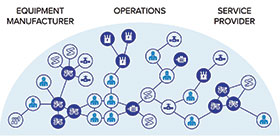

Today’s Industrial Internet of Things (IIoT) encompasses advances in sensor technologies, connectivity, analytics and cloud environments that will expand the impact of data on enterprise performance management. Recent market analysis predicts that lowered sensor cost, energy requirements and ease of connectivity will result in an explosion of industrial sensors and sensor-based data. For example, Cisco’s Internet Business Solutions Group predicts that by 2020, 50 billion IIoT devices will be deployed and active.
A definition for Industrial Internet of Things
The connection of digitally networked sensors and sensor-based data to visualisation and analytics environments hosted in the cloud or on premises. IIoT enriches existing data ecosystems to enhance decision support for actions influencing control, design and service in industrial operations.
Introduction
Collecting data and transmitting data from industrial machines and devices is not a new concept. Since the early ‘80s, data from industrial assets has been captured, stored, visualised and analysed to improve key business impacts such as asset health, resource conservation and process efficiency. This article explores some of the challenges, benefits and strategy of adopting IIoT technologies to create a ‘hybrid’ sensor-based data environment. Capturing information illuminated by IIoT sensors will enrich existing industrial sensor-based data ecosystems to transform operations, business models and the ways organisations communicate with customers, supply chain and business partners.
In B2C markets, embedded technology is enabling manufacturers to assess device usage patterns, upgrade products remotely and offer additional aftermarket services. In B2B or industrial settings, IIoT offers the opportunity to connect operators, engineers and managers to a richer data landscape in order to improve operational visibility and sharpen operational insight.
Asset performance management
Through either remote or on premises monitoring, sensor data supplementing existing operational sensor-based data ecosystems can enhance real-time situational awareness, close information gaps and operationalise assets that were previously unmonitored or monitored manually. IIoT broadens the scope of asset data sources to heighten texture and resolution of existing information. Industries can use information to streamline maintenance costs, improve process efficiency and increase asset availability.
Improved planning and productivity
IIoT enables industries to monitor the physical state or location of people as well as mobile or geographically dispersed assets. When combined with process or asset data, industries can operationalise data sources that surround core industrial machinery to reduce risk, enhance safety, field force and operational efficiencies.
Data-driven communication with customers, partners and communities
IIoT sensors and devices produce data and information relevant to broader ecosystems. Sharing data across these ecosystems will transform communication between customers, businesses and across larger ecosystems. Secure data exchange across these broader data environments will create new business models and associated revenue streams through opportunities such as expanded service offerings, establishing data-driven collaboration and partnerships.
As advances in technology make it more cost-effective to deploy IIoT, industries will need to develop a strategic approach to integrating IIoT sensor data with pre-existing data environments. Creating a seamless, extensible data ecosystem will require cooperation between multiple vendors, partners and system integrators.
As IIoT continues to evolve, OSIsoft and its extended partner Ecosphere are working to advance the PI system to support change, enabling our customers and partners to embrace IIoT opportunities in a continued, scalable and persistent manner.
Anyone interested in learning about OSIsoft and the PI system in the world of IIoT should attend the EMEA Users Conference 2016 in Berlin 26-29 September. Details and special offers please contact Nick Stead [email protected] website: www.osisoft.com
For more information contact Nick Stead, OSIsoft, +27 (0)31 764 0929, [email protected], www.osisoft.com

© Technews Publishing (Pty) Ltd | All Rights Reserved